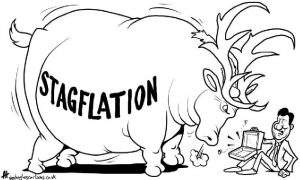I had written this article for my blog in December 2019 stating that according to the newspaper Mint dated 19th Nov 2019, former Prime Minister and economist Dr. Manmohan Singh has cautioned that while India is not yet in stagflation territory, it would be prudent to watch out for increased risks of such an event occurring.
Last year, Moody’s Analytics, research arm of ratings agency Moody’s, said that India had entered into a stagflation phase with notably weaker growth but inflation still stubbornly high. Fitch ratings had also said that that the combination of high inflation and slow GDP growth implies that India may have entered into stagflation. Technically, it was not right to say India is faced with stagflation then in Dec 2019. But, today it looks that Moody Analytics might prove to be true….
A sharp decline in consumer spending in the European Union and the United States will reduce imports of consumer goods from developing countries. Developing countries, particularly those dependent on tourism and commodity exports, face heightened economic risks. Global manufacturing production could contract significantly, and the plunging number of travellers is likely to hurt the tourism sector in small island developing States, which employs millions of low-skilled workers.
Before the outbreak of the COVID-19, world output was expected to expand at a modest pace of 2.5 per cent in 2020, as reported in the World Economic Situation and Prospects 2020.
On 12th March 2020 Beijing News.Net has carried a news article that a range of financial institutions around the world have admitted that the corona virus pandemic would have a hard impact on the world economy. Countries around the world are facing the upcoming slowdown. US Federal Reserve has already slashed interest rates by a half-point, CNN reported. Though the likelihood of inflation is low, the threat of stagflation is for real. The global uptick in the Gross Domestic Product (GDP) could be as low as 1 percent this year, reports the Institute for International Finance (IIF) in last week of March 2020.
Stagflation is an economic cycle in which there is a high rate of inflation and also stagnation. Inflation occurs when the general level of prices in an economy increases, which means value of money falls. Stagnation occurs when the production of goods and services in an economy slows down or even starts to decline.
Stagflation, in this view, is caused by cost-push inflation. Cost-push inflation occurs when some force or condition increases the costs of production. This could be caused by government policies (such as taxes) or from purely external factors such as a shortage of natural resources or in a situation like war. Stagflation slows economic growth and creates rather high unemployment. It can also be defined as inflation and a decline in gross domestic product (GDP). But, a fact of stagflation is that real estate and commodities like gold, silver and platinum do well. Investment in these assets is a good decision.
Stagflation is costly and difficult to eliminate, both in social and fiscal terms. There are only a few examples in history and the most notable one occurred in the 1970s in the United States. The onset of stagflation In the 1970s was blamed on the US Federal Reserve’s unsustainable economic policy during the boom years of the late 1950s and 1960s. The Fed moved to keep unemployment low and boosted overall demand for products and services in the 1960s. However, the unnaturally low unemployment during the decade triggered something called a wage-price spiral. The wage-price spiral is a macroeconomic theory used to explain the cause-and-effect relationship between rising wages and rising prices, or inflation. The wage-price spiral suggests that rising wages increase disposable income raising the demand for goods and causing prices to rise.
The OPEC oil prohibition in 1973 also contributed to the unwanted economic event in the US. Industries across the country suffered from excessively high oil prices and shortages. Demand fell to new lows and industrial output suffered.
Theories on the Causes of Stagflation
One theory states that this economic phenomenon is caused when there is a sudden rise in the cost of oil. It reduces an economy’s productive capacity. In October 1973, the OPEC (Organization of Petroleum Exporting Countries) issued a restriction against Western countries. This caused the global price of oil to rise dramatically, thereby increasing the costs of goods and contributing to a rise in unemployment. Because transportation costs rose, producing products and getting them to shelves became more expensive and prices rose even as people got laid off. Critics of this theory point out that sudden oil price shocks like those of the 1970’s did not occur in connection with any of the simultaneous periods of inflation and recession that have occurred since then.
Another theory is that the convergence of stagnation and inflation are results of poorly made economic policy. Harsh regulation of markets, goods and labour in an otherwise inflationary environment are cited as the possible cause of stagflation. Confluence of stagnation and inflation are results of poorly made economic policy. Harsh regulation of markets, goods and labour in an otherwise inflationary environment are cited as the possible cause of stagflation. Some point fingers to the policies set by former US President Richard Nixon, which may have led to the recession of 1970; he is blamed for the period of stagflation. Nixon put tariffs on imports and froze wages and prices for 90 days, in an effort to prevent prices from rising. Once the controls were relaxed, the sudden economic shock of oil shortages and rapid acceleration of prices led to economic chaos in US. While appealing to the former theory of OPEC’s ban of few nations, Nixon’s policies are basically an ad-hoc explanation of the stagflation of the 1970’s, which does not explain the simultaneous rise in prices and unemployment that has accompanied subsequent recessions up to the present.














































